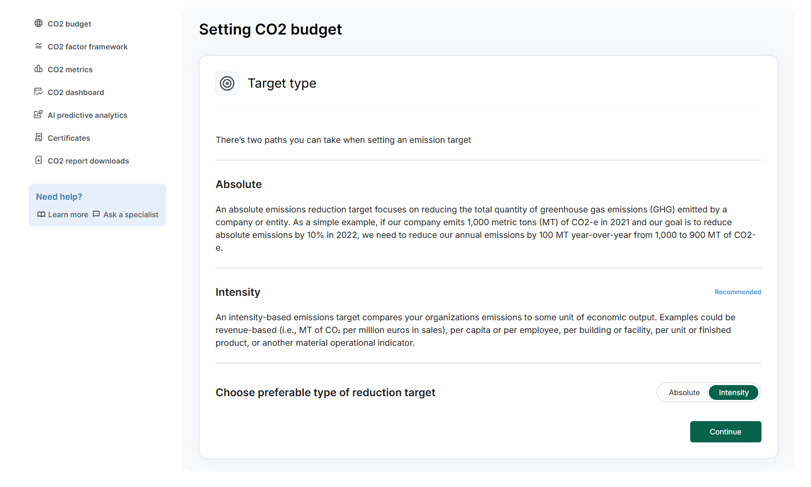Set emission targets for your business travel easily, with Goodwings
Book a live demo to get a quick intro to the Goodwings platform.
Set credible travel emissions targets with clear baselines, ambition frameworks, mitigation levers and actionable sub-targets for measurable progress.

Setting credible emissions targets has gone from nice to have to non-negotiable. Without clear, measurable goals for reduction, even genuine sustainability efforts can come across as vague or unconvincing - or even worse, be considered greenwashing - eroding trust and slowing progress.
We don't travel THAT much - is it necessary to set a target for business travel?
We get it. Travel might seem like a small piece of the puzzle, but it can be a major lever for impact. Business travel makes up around 15–20 % of global travel emissions, while aviation accounts for roughly 2.5 % of global energy-related CO₂ emissions.
The message?
Travel isn’t a fringe emissions source, especially for service-based or globally active companies.
The good news?
Companies are waking up. According to GBTA’s 2023 benchmark, 62 % already track their business travel emissions, and another 14 % plan to within a year.
The but...
Tracking is only step one - the real gap lies in action. According to the 2024 Travel Smart ranking report, 83% of global companies still don’t have credible plans to reduce corporate flying emissions. In short, most businesses know their footprint but haven’t set a plan to shrink it.
That’s where targets come in. A travel emissions target turns awareness into action — a measurable, adaptable roadmap that helps companies cut emissions, stay accountable, and lead by example.
In this blog, we’ll guide you through transforming your travel target into an active management tool - a practical way to measure performance, steer your carbon budget, and chart your course with confidence. It’s not just a metric to monitor, but a strategic foundation your business can rely on.
What’s a travel emissions target? 🤔
Simply put, a travel emissions target is a formal commitment by a company to reduce its greenhouse gas emissions from business travel (flights, train, car, etc.) over a defined period. It involves choosing:
In short: while tracking shows you where you are, target setting gives you direction. It shifts your travel emissions strategy from reactive to proactive. |
Setting a target isn’t about perfect predictions — it’s about creating a direction, aligning incentives, and enabling feedback loops.
In many service- and knowledge-based organizations, business travel is one of the biggest “outside your walls” emissions drivers. It’s part of Scope 3, Category 6 (Business Travel) under the GHG Protocol. (ghgprotocol.org)
Investors, customers, and regulators increasingly expect credible, science-aligned climate strategies — not vague promises.
You gain clarity and agency
A target can work as a north star for how you conduct business and business travel (e.g. to prioritize rail vs flights, reduce meeting travel, and refine your travel policy).
Frameworks like CSRD, SECR, and others increasingly require Scope 3 reporting.
Showing you have a real emissions goal helps you stand out in ESG-conscious markets.
How to set a target
We've based this quick-guide on the guidance from the GHG Protocol and Science Based Targets initiative (SBTi).
1. Define your boundary and scope: what exactly “counts” as travel emissions
Before you set a target, you’ve got to be crystal clear on what’s in scope.
Clearly defining your scope ensures your travel emissions reporting aligns with recognized standards like the GHG Protocol and the Science Based Targets initiative. Once you know what’s in (and what’s out), you’re ready to set a target that’s both credible and science-aligned. 2. Build your baseline
If you think of travel emission reduction as a marathon, the target is your finish line - and your baseline is your starting line. You’ll use it to track progress and pace, and to make sure your results are repeatable.
3. Choose your target - and ambition
How much do you commit to cut, and by when? This is where you decide what kind of target you want to set, and when you plan to achieve it:
Explore how Goodwings can help you set - and meet - reduction targets here. |
Setting a travel emissions target is one thing - keeping it measurable, visible, and actionable is another. That’s where the Goodwings sustainability suite comes in. The platform lets you create, monitor, and reach your reduction goals with data-driven insights and built-in behavioral tools that make every booking count.

Your first step is defining how much CO₂ your company can “spend” on travel. In the platform, you can set a company-wide carbon budget and even allocate sub-budgets to teams or individuals. Excess alerts notify you when emissions are close to exceeding your target, keeping everyone accountable in real time.
Goodwings supports two target types, depending on how your business measures progress:
Absolute target – Focuses on cutting total emissions. For example: if your 2024 footprint is 1,000 t CO₂e and you want a 10 % reduction in 2025, your annual cap becomes 900 t CO₂e.
Intensity-based target (recommended) – Tracks emissions relative to a key indicator, such as revenue or number of employees (e.g., t CO₂e per FTE or per million € revenue). This allows you to measure efficiency improvements as the company grows.
Once your target is set, Goodwings helps you design smart travel policies that make reductions achievable:
Set maximum CO₂ per passenger km thresholds
Limit highest cabin class or maximum flight distance
Encourage rail over air for short routes
Use policy alerts to flag high-carbon bookings before they’re confirmed.
These policies connect directly to your carbon budget, ensuring daily travel decisions align with your long-term goals.
Get emission data and insights directly in your dashboard:
Your CO₂ dashboard delivers real-time visibility into your company’s emissions, broken down by route, department, or traveler.
AI powered forecasting to help you plan ahead:
With our unique CO₂ forecasting tool, you’ll receive actionable recommendations for limiting and reducing emissions, along with predictive graphs that show the impact of your travel policies and projected future emissions. Leveraging predictive analytics, you can model future outcomes based on booking behaviors, revealing how measures like shifting to rail or adjusting travel budgets directly influence your progress toward reduction targets.
In the My Climate dashboard, every traveler can see how their trips contribute to company goals and monitor their own footprint. AI nudges and low-emission booking suggestions promote better travel habits without adding extra admin.
When it’s time to report progress, you can export ESG-ready CO₂ reports directly from the platform. Reports are filterable by date, entity, or traveler, and align with global frameworks like DEFRA, EPA, and ICAO.
Start your travel emission reduction journey with us today. Book a chat with Goodwings to see how we can help you set targets for your business travel.
|
It's a great idea to do a "sanity check" before launching your target. Look at what peer organizations are pledging to ensure your target is ambitious but realistic, allowing operational flexibility for growth. Here are a few examples of SBTI validated targets.
| Company | Target (Business Travel) | How they set/committed | Company size and industry | SBTi validated? |
|---|---|---|---|---|
| McKinsey & Company | Reduce per-employee business travel emissions by 35% by 2025, 55% by 2030 and 97% by 2050 vs 2019 baseline. Intensity based target |
Integrated travel target within their firmwide 1.5°C-aligned climate strategy; published progress reports annually. | ~45,100 employees Management consulting |
Validated by SBTi (1.5°C pathway) |
| Boston Consulting Group (BCG) | Reduce business travel emissions per FTE by 48.5% by 2025 (vs 2018 baseline). Intensity based target |
Embedded in corporate climate roadmap; progress tracked and reported publicly. |
~33,000 employees
Management consulting |
Validated by SBTi |
| PwC (Global) | Reduce absolute business travel emissions by 50% by 2030 (vs FY2019). Absolute target |
Included travel as part of Scope 3 target in its global net-zero plan. |
~370,000+ employees
Professional services |
Validated by SBTi (net-zero by 2030) |
| Jacobs Solutions Inc. | Reduce business travel and employee commuting emissions by 50% by 2030 (vs 2019). Absolute target |
Target set under SBTi’s “Absolute Contraction” method; included travel as key Scope 3 category. |
~45,000–55,000 employees
Engineering & technical services |
Validated by SBTi |
| AECOM | Reduce business travel emissions by 50% by 2030 and 90% by 2040. Absolute target |
Defined in their “Travel with Purpose” strategy; part of broader Sustainable Legacies net-zero roadmap. |
~51,000 employees
|
Validated by SBTi |
| Akind Venture AB |
Absolute target |
Business travel explicitly covered in Scope 3 category. Near-term and long-term targets validated under the SBTi Net-Zero Standard. |
~600 employees
Professional services / HR & staffing solutions |
Validated by SBTi (near-term + long-term Net Zero). |
Aligning your travel targets with the SBTiIf your company is working toward SBTi verification, your travel emissions targets need to meet the same scientific rigor as the rest of your climate goals. For companies with notable air travel footprints, the SBTi’s Aviation Guidance outlines clear rules: ● If Scope 3 emissions (including business travel) make up 40 % or more of your total footprint, you must set a Scope 3 target. ● That target must cover at least two-thirds of total Scope 3 emissions. ● For aviation and business travel (Scope 3 Category 6), the Absolute Contraction Approach is required — committing to real annual emission cuts of at least 1.23 % over a 5–15-year period. Through our #MoveTheTravel campaign in partnership with We Don’t Have Time, we unpack what the SBTi is, its tailored roadmap for aviation, and the frameworks empowering businesses to reduce travel-related emissions. 👉 Read our full deep dive into the SBTi’s aviation guidance here |
|
Discover why you need a corporate travel policy that reduces business travel costs, delivers on sustainability targets, and sets fair and equitable...
Cut costs, boost sustainability, and stay ahead of regulations—discover how creating a carbon budget helps reduce emissions and drive real change
Discover how SAF can drive the transition to fossil-free travel, its environmental benefits, and the obstacles to its widespread adoption.
CO2 estimates can vary depending on different calculation methodologies - also known as frameworks - and it can be difficult to choose the right...